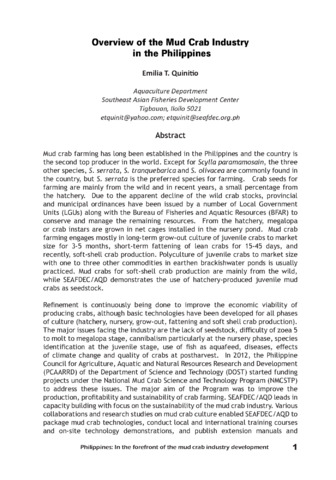Morphological deformities in mud crab Scylla serrata juveniles exposed to antibiotics during the larval stage
- Global styles
- MLA
- Vancouver
- Elsevier - Harvard
- APA
- Help

View/Open
Date
2017Page views
1,628ASFA keyword
AGROVOC keyword
Taxonomic term
Metadata
Show full item recordCited times in Scopus
20 readers on Mendeley
- Citations
- CrossRef - Citation Indexes: 3
- Scopus - Citation Indexes: 6
- Captures
- Mendeley - Readers: 20
Share
Abstract
The effects of antibiotics on the external deformities, growth and survival of mud crab Scylla serrata larvae and juveniles were determined. Zoeae were exposed to oxytetracycline (OTC) (0, 3.0, 6.0, 9.0, 12 mg L-1) and furazolidone (FZD) (0, 0.5, 1.0, 1.5, 2.0 mg L-1) in the first and second experiments, respectively, until the late megalopa. The crab instars were grown in nursery tanks for 1 month. Larvae survived until megalopa only at 3.0 and 6.0 mg L-1 OTC or 0.5 and 1.0 mg L-1 FZD. These four concentrations were run simultaneously in another experiment. Morphological deformities in zoea 5 were bent dorsal, rostral and furcal spines. There was no significant difference (P > 0.05) on the deformities of zoea 5 in 3.0 and 6.0 mg L-1 OTC and 0.5 and 1.0 mg L-1 FZD. Significantly (P < 0.05) higher survival and faster growth were attained in 3.0 mg L-1 OTC and 0.5 mg L-1 FZD. Deformities observed in juveniles were fused frontal and lateral spines, asymmetrical and depressed tip of abdominal flap and gap between sternites. High percentage occurrence of deformities was observed in the 6.0 mg L-1 OTC and 1.0 mg L-1 FZD in the first and third experiments, respectively. There was no significant difference (P > 0.05) observed in the survival of juveniles in OTC and FZD treatments. However, growth was significantly (P < 0.05) faster in lower concentrations of the two antibiotics. The study shows the effects of OTC and FZD in the morphology of mud crab. Therefore, there is a need to eliminate the use of antibiotics and find alternatives.
Suggested Citation
Pates, G. S., Jr., Quinitio, E. T., & Parado-Estepa, F. D. (2017). Morphological deformities in mud crab Scylla serrata juveniles exposed to antibiotics during the larval stage. Aquaculture Research , 48(5), 2102-2112. https://doi.org/10.1111/are.13046
Type
ArticleISSN
1355-557X; 1365-2109Collections
- Journal Articles [1247]
Related items
Showing items related by title, author, creator and subject.
-
Larval rearing of mud crab (Scylla): What lies ahead
Waiho, Khor; Fazhan, Hanafiah; Quinitio, Emilia T. ; Baylon, Juliana C.; Fujaya, Yushinta; Azmie, Ghazali; Wu, Qingyang; Shi, Xi; Ikhwanuddin, Mhd; Ma, Hongyu (Elsevier, 2018)
The increasing global demand for mud crabs (genus Scylla) and threats to the wild populations highlight the urgency of fully rearing them in captivity. Despite considerable progress in mud crab production, most crab farms ...8787 Total citations33 Recent citations15 Field Citation Ration/a Relative Citation Ratio
; Baylon, Juliana C.; Fujaya, Yushinta; Azmie, Ghazali; Wu, Qingyang; Shi, Xi; Ikhwanuddin, Mhd; Ma, Hongyu (Elsevier, 2018)
The increasing global demand for mud crabs (genus Scylla) and threats to the wild populations highlight the urgency of fully rearing them in captivity. Despite considerable progress in mud crab production, most crab farms ...8787 Total citations33 Recent citations15 Field Citation Ration/a Relative Citation Ratio
-
Diseases in farmed mud crabs Scylla spp.: Diagnosis, prevention, and control.
Lavilla-Pitogo, Celia R.; de la Peña, Leobert D. (Aquaculture Dept., Southeast Asian Fisheries Development Center, 2004-12)Aquaculture production has suffered many set-backs due to the occurrence of diseases. Many of the diseases are caused by infectious organisms that are difficult to detect and need sophisticated instruments for diagnosis, ... -
Overview of the mud crab industry in the Philippines
Mud crab farming has long been established in the Philippines and the country is the second top producer in the world. Except for Scylla paramamosain, the three other species, S. serrata, S. tranquebarica and S. olivacea ...






